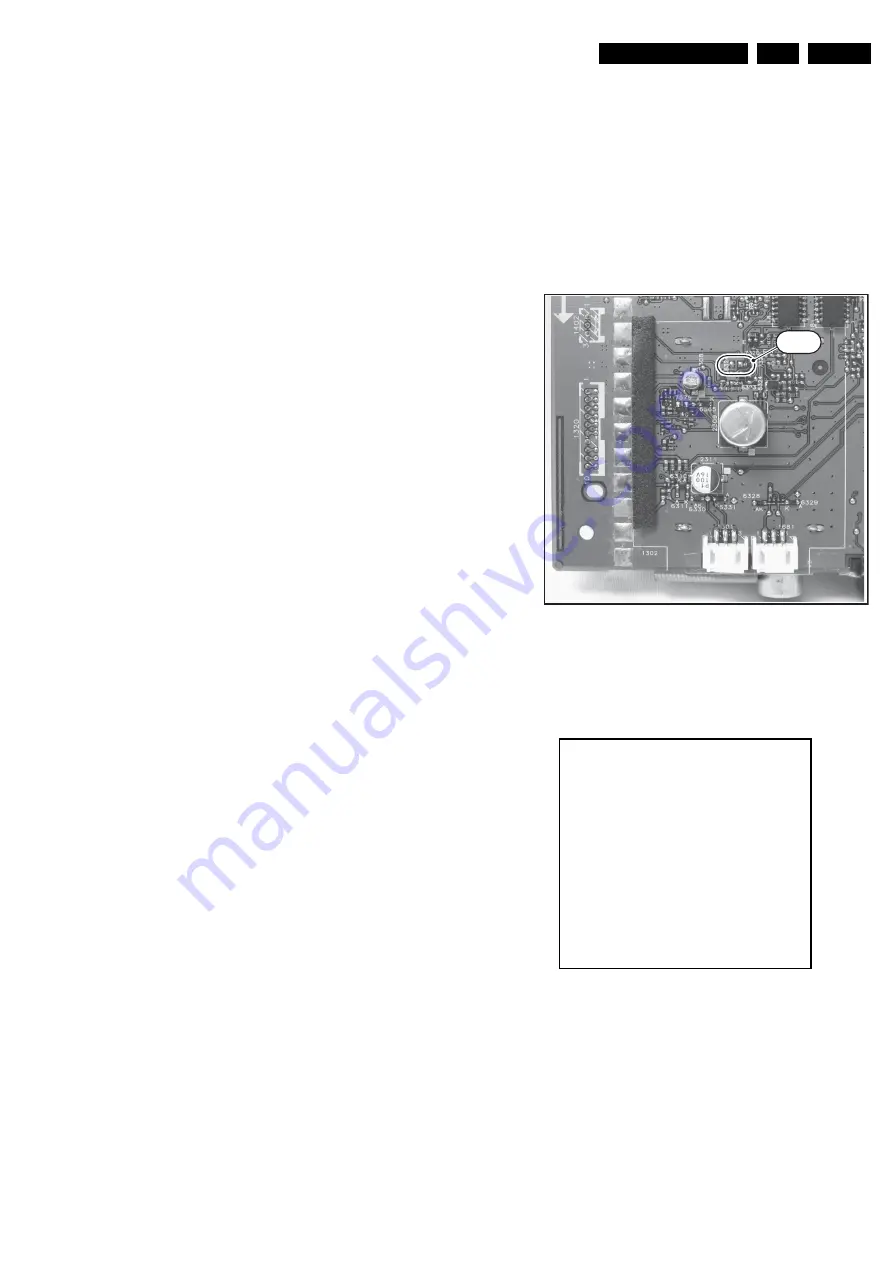
Service Modes, Error Codes, and Fault Finding
5.
5.
Service Modes, Error Codes, and Fault Finding
Index of this chapter:
5.1 Test Points
5.2 Service Modes
5.3 Problems and Solving Tips Related to CSM
5.4 ComPair
5.5 Error Codes
5.6 The Blinking LED Procedure
5.7 Fault Finding and Repair Tips
5.1
Test Points
This chassis is equipped with test points in the service printing.
In the schematics test points are identified with a rectangle box
around Fxxx or Ixxx. These test points are specifically
mentioned in the service manual as “half moons” with a dot in
the centre.
Perform measurements under the following conditions:
•
Television set in Service Default Alignment Mode.
•
Video input: Colour bar signal.
•
Audio input: 3 kHz left channel, 1 kHz right channel.
5.2
Service Modes
Service Default mode (SDM) and Service Alignment Mode
(SAM) offers several features for the service technician, while
the Customer Service Mode (CSM) is used for communication
between the call centre and the customer.
This chassis also offers the option of using ComPair, a
hardware interface between a computer and the TV chassis. It
offers the abilities of structured troubleshooting, error code
reading, and software version read-out for all chassis.
Minimum requirements for ComPair: a Pentium processor, a
Windows OS, and a CD-ROM drive (see also paragraph
"ComPair").
5.2.1
Service Default Mode (SDM)
Purpose
•
To create a predefined setting for measurements to be
made.
•
To override software protections.
•
To start the blinking LED procedure.
•
To inspect the error buffer.
•
To check the life timer.
Specifications
•
Tuning frequency: 475.25 MHz.
•
Colour system: PAL B/G.
•
All picture settings at 50% (brightness, colour contrast,
hue).
•
Bass, treble and balance at 50%; volume at 25%.
•
All service-unfriendly modes (if present) are disabled. The
service unfriendly modes are:
–
Timer / Sleep timer.
–
Child / parental lock.
–
Blue mute.
–
Hotel / hospital mode.
–
Auto shut off (when no “IDENT” video signal is
received for 15 minutes).
–
Skipping of non-favourite presets / channels.
–
Auto-storage of personal presets.
–
Auto user menu time-out.
–
Auto Volume Levelling (AVL).
How to enter
To enter SDM, use one of the following methods:
•
Press the following key sequence on the remote control
transmitter: “062596” directly followed by the MENU
button (do not allow the OSD display to time out between
entries while keying the sequence).
•
Short SDM jumper (item 4022, see Figure "Service
jumper") on the TV board and apply AC Power. Remove
the short after start-up.
Caution: Entering SDM by shorting "Service" jumpers will
override the software protections. Do this only for a short
period. When doing this, the service-technician must
know exactly what he is doing, as it could damage the
television set.
Figure 5-1 SDM Service jumper
After entering SDM, the following screen is visible, with SDM in
the upper right corner of the screen to indicate that the
television is in Service Default Alignment Mode.
Figure 5-2 SDM menu (example from LC4.2E)
How to navigate
When you press the MENU button on the remote control, the
set will switch on the normal user menu in the SDM mode.
How to exit
Switch the set to STANDBY by pressing the POWER button on
the remote control transmitter.
If you turn the television set off by removing the mains (i.e.,
unplugging the television) or by using the POWER button on
the TV set, the television set will remain in SDM when mains is
re-applied, and the error buffer is not cleared.
I
2
C
UART
E_14710_062.eps
260804
SDM
00022 LC42EP1 2.03/S42GV1 2.02 SDM
ERR 0 0 0 0 0
OP 000 057 140 032 120 12
8
000
E_14710_006.eps
240604










































